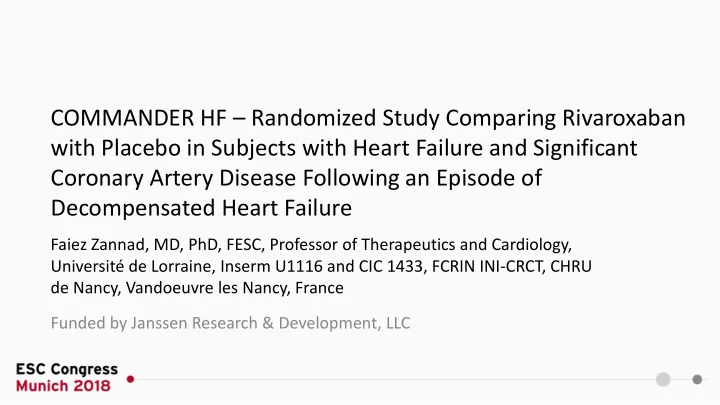

COMMANDER HF – Randomized Study Comparing Rivaroxaban with Placebo in Subjects with Heart Failure and Significant Coronary Artery Disease Following an Episode of Decompensated Heart Failure Faiez Zannad, MD, PhD, FESC, Professor of Therapeutics and Cardiology, Université de Lorraine, Inserm U1116 and CIC 1433, FCRIN INI-CRCT, CHRU de Nancy, Vandoeuvre les Nancy, France Funded by Janssen Research & Development, LLC
Declaration of Interest • Faiez Zannad is co-chair of the steering committee of COMMANDER HF, consultant to Bayer and has no other conflict of interest related to the current work.
Background • The majority of patients with chronic heart failure (HF) with reduced ejection fraction have significant coronary artery disease (CAD) • For patients who suffer an episode of decompensated HF, the prognosis is poor with a high rate of readmission and death, despite advances in treatment • Thrombin-mediated pathways may play a critical role in the disease progression of heart failure, but prior research with warfarin was inconclusive • A randomized study was needed to determine whether the prevention of thrombin-mediated events with a direct oral anticoagulant would improve outcomes for chronic HF patients with reduced ejection fraction and significant CAD following an episode of decompensated HF
Study Outcomes Primary Efficacy Outcome Principal Safety Outcome • Composite of fatal bleeding, or bleeding into a critical space (intracranial, intraspinal, intraocular, • Composite of all-cause mortality, myocardial infarction, or stroke following an pericardial, intra-articular, retroperitoneal, index event intramuscular with compartment syndrome) with a potential for permanent disability Secondary Efficacy Outcomes Other Safety Outcomes • Composite of CV mortality or rehospitalization for worsening of HF • Bleeding events requiring hospitalization • CV mortality • Major bleeding events using the International Society on Thrombosis and Haemostasis (ISTH) • Rehospitalization for worsening of HF bleeding criteria • Rehospitalization for CV events
Study Design Follow-Up Double Blind Treatment Screening After GTED Phase Period Rivaroxaban 2.5 mg bid + standard of care therapy 30 ± 15 ≤ 21 days of Index days Event q 12 weeks End of Study R N = 5000 Patients with HF-rEF Visit and CAD are appropriate regardless Placebo bid + standard of care therapy of whether they are managed via the traditional inpatient At hospital Visits: Early Permanent hospital pathway or via discharge & up to 30 *Global Treatment Day 1 = R Study Drug the outpatient HF End Date days post discharge Week 4 Discontinuation clinic pathway (GTED) Week 12 Continue Follow-Up q 3 months 6 Zannad F, et al. Eur J Heart Fail. 2015:17(7):735-742
Primary Efficacy Outcome & Components (ITT, Up to GTED) Rivaroxaban Placebo Rivaroxaban vs. Placebo Event Rate Event Rate Log-rank Outcomes n (%) / (100 pt-yr) n (%) / (100 pt-yr) HR (95% CI) P-value N=2507 N=2515 Primary efficacy (composite) 626 (25.0) 13.44 658 (26.2) 14.27 0.94 (0.84, 1.05) 0.27 All-cause mortality 546 (21.8) 11.41 556 (22.1) 11.63 0.98 (0.87, 1.10) - MI 98 ( 3.9) 2.08 118 ( 4.7) 2.52 0.83 (0.63, 1.08) - Stroke 51 ( 2.0) 1.08 76 ( 3.0) 1.62 0.66 (0.47, 0.95) - GTED = Global Treatment End Date; MI = myocardial infarction; HR = hazard ratio; CI = confidence interval Note: HR (95% CI): Hazard ratios (95% confidence interval) are from a Cox proportional hazards model stratified by region with treatment assignment as the only effect.
Principal Safety Outcome (On-Treatment, Safety Analysis Set) Rivaroxaban Placebo Rivaroxaban vs. P value Placebo N=2499 N=2509 Principal safety (composite) 18 ( 0.7) 0.44 23 ( 0.9) 0.55 0.80 ( 0.43, 1.49) 0.484 Fatal bleeding 9 ( 0.4) 0.22 9 ( 0.4) 0.22 1.03 ( 0.41, 2.59) 0.951 Bleeding in critical space with 13 ( 0.5) 0.32 20 ( 0.8) 0.48 0.67 ( 0.33, 1.34) 0.253 potential for permanent disability ISTH major bleeding 82 ( 3.3) 2.04 50 ( 2.0) 1.21 1.68 ( 1.18, 2.39) 0.003 ISTH: HGB decreases ≥ 2g/dL 55 ( 2.2) 1.37 30 ( 1.2) 0.73 1.87 ( 1.20, 2.91) 0.005 ISTH: transfusions ≥ 2 Units 31 ( 1.2) 0.77 18 ( 0.7) 0.43 1.74 ( 0.98, 3.12) 0.058 ISTH: critical bleeding sites 25 ( 1.0) 0.62 23 ( 0.9) 0.56 1.12 ( 0.63, 1.97) 0.699 ISTH: fatal outcome 3 ( 0.1) 0.07 7 ( 0.3) 0.17 0.45 ( 0.12, 1.72) 0.228 Bleeding requiring hospitalization 61 ( 2.4) 1.52 48 ( 1.9) 1.16 1.30 ( 0.89, 1.90) 0.170
Conclusion In patients with recent worsening of chronic HF and reduced ejection fraction who also have underlying CAD and are not in atrial fibrillation, low-dose rivaroxaban, when added to guideline-based therapy, does not improve the composite of all-cause mortality, myocardial infarction, or stroke, nor does it favorably influence heart failure rehospitalization 9
Comments 1. Heart failure readmission was the single most frequent event in the trial 2. It is likely that heart failure, rather than deaths mediated by atherothrombotic events, contributed to a substantial proportion of all deaths. 3. Thrombin-mediated events are not the major driver of heart failure-related events in patients with recent heart failure hospitalization. 4. Whether a higher dose of rivaroxaban could have led to a more favorable outcome remains unknown. 5. In patients with chronic heart failure with reduced ejection fraction remain at high long-term risk for death and cardiovascular events despite treatments targeted at a variety of mechanistic pathways. Thus, there is an important unmet need to find novel approaches to reduce the morbidity and mortality in this population.
Recommend
More recommend